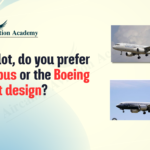The preference between Airbus and Boeing cockpit designs often comes down to personal experience, training, and flying style. Both manufacturers are renowned for their high standards of safety, innovation, and ergonomics, but they approach cockpit design differently. Here’s a comparison to help pilots (and enthusiasts) understand the distinctions:
1. Airbus Cockpit Design
– Philosophy: Focus on automation and simplicity, emphasizing the pilot’s role as a system manager.
– Key Features:
– Side-Stick Controller: Airbus aircraft use a side-stick instead of a traditional control column, allowing for a less obstructed view and more space.
– Fly-by-Wire System: Automated protections help prevent overstressing the aircraft (e.g., avoiding excessive bank or pitch angles).
– Standardized Layout: Airbus aims for cockpit commonality across models (A320, A330, A350, etc.), making it easier for pilots to transition between aircraft.
– Glass Cockpit: Comprehensive, digital instrumentation on large screens provides clean and intuitive displays.
– Advantages:
– Reduces pilot workload with high levels of automation.
– Enhanced situational awareness through modern avionics.
– Ergonomic side-stick design for comfort during long flights.
– Challenges:
– Some pilots feel the automation reduces “hands-on” flying.
– The side-stick lacks physical feedback compared to the yoke, which can be an adjustment for those used to Boeing.
2. Boeing Cockpit Design
– Philosophy: Pilot-centric with a balance of manual control and automation, keeping the pilot as the primary decision-maker.
– Key Features:
– Control Yoke: Boeing uses a traditional yoke, offering tactile feedback that some pilots prefer for precision and situational control.
– Fly-by-Wire with Pilot Authority: While newer Boeing models (e.g., 787) use fly-by-wire, the system allows pilots to override certain protections.
– Logical Layout: Boeing cockpits are designed for ease of use, with intuitive grouping of instruments and controls.
– Legacy Continuity: Many systems and designs are consistent across Boeing models, aiding familiarity for experienced Boeing pilots.
– Advantages:
– Provides a more “connected” flying experience, especially for pilots who enjoy manual flying.
– Physical feedback from the control yoke can help during critical maneuvers.
– Well-suited for pilots transitioning from older models or different Boeing aircraft.
– Challenges:
– Cockpit design can feel less modern in older models compared to Airbus.
– Some argue the yoke takes up more space and can be less ergonomic over time.
—
Pilot Preferences
– Airbus Fans:
– Prefer the modern and highly automated systems that minimize workload.
– Appreciate the uniformity in cockpit design across the Airbus family.
– Boeing Fans:
– Value the tactile control of the yoke and the balance between manual and automated systems.
– Enjoy the tradition and feel of flying a Boeing, especially for those with a love for aviation’s heritage.
—
Which is Better?
There’s no definitive answer—it depends on the pilot’s personality, training, and priorities. Some pilots may find Airbus’s side-stick and automation more comfortable, while others may prefer the tactile control and familiarity of Boeing’s yoke. Both designs represent decades of innovation and safety-first thinking.






